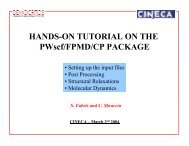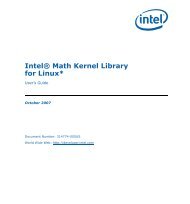Notes on pseudopotential generation
Notes on pseudopotential generation
Notes on pseudopotential generation
Create successful ePaper yourself
Turn your PDF publications into a flip-book with our unique Google optimized e-Paper software.
1.2 About similar work<br />
There are at least three well-known published sets of PP’s: those of Bachelet, Hamann,<br />
and Schlüter [1](BHS), those of G<strong>on</strong>ze, Stumpf, and Scheffler [2], and those of Goedecker,<br />
Teter, and Hutter [3]. These published tables are a very good and important piece of<br />
work. If a published PP suits your needs, you should definitely use it and cite it.<br />
One could then w<strong>on</strong>der what a PP generati<strong>on</strong> code is useful for. The problem is that<br />
sometimes published PP’s will not suit your needs. For instance:<br />
– the alkali atoms from the BHS tables are ok if you calculate properties of alkali<br />
metals, but they yield poor equilibrium lattice parameters in alkali halides (this<br />
is why I started with the PP of Cs in CsI, by the way). In such compounds you<br />
definitely need the ”core correcti<strong>on</strong>” of Froyen, Louie, and Cohen [4].<br />
– there are many gradient-corrected functi<strong>on</strong>als around, but <strong>on</strong>ly a few published<br />
gradient-corrected PP’s.<br />
– you may need a distincti<strong>on</strong> between ”valence” and ”core” electr<strong>on</strong>s that is different<br />
from the <strong>on</strong>e chosen in the tables.<br />
– you may need “softer” PP’s than those of the tables.<br />
There are other PP generati<strong>on</strong> packages available <strong>on</strong> <strong>on</strong>-line (I am aware of the code<br />
by José-Luís Martins et al.: http://bohr.inesc-mn.pt/~jlm/pseudo.html, and of<br />
the fhi98PP package [5]), or up<strong>on</strong> request from the authors (I have heard of codes by<br />
Hamann and by Bachelet). If you are happy with a given code, use that <strong>on</strong>e. If you<br />
are happy with this, use this.<br />
Years ago, it occurred to me that a web-based PP generati<strong>on</strong> tool would have been<br />
nice. Being too lazy and too ignorant in web-based applicati<strong>on</strong>s, I did nothing. I<br />
recently discovered that Miguel Marques et al. have implemented something like this:<br />
see http://www.tddft.org/programs/octopus/pseudo.php.<br />
Ultrasoft (Vanderbilt) PP’s are a wholly different story. David Vanderbilt’s package<br />
can be found <strong>on</strong>-line at: http://www.physics.rutgers.edu/~dhv/uspp/index.html.<br />
2 Pseudopotential generati<strong>on</strong>, in general<br />
In the following I am assuming that the basic theory of PP is known to the reader. If<br />
not, a good starting point is ref.[5] and references quoted therein. I am also assuming<br />
that the generated PP’s are to be used with a plane-wave (PW) basis set.<br />
The PP generati<strong>on</strong> is a three-step process. First, <strong>on</strong>e generates DFT atomic levels<br />
and wavefuncti<strong>on</strong>s. From this, <strong>on</strong>e generates the PP. Then, <strong>on</strong>e checks whether what<br />
he just did is useful, and if it is not, tries again in a different way.<br />
The first step is invariably d<strong>on</strong>e assuming a spherically symmetric self-c<strong>on</strong>sistent<br />
Hamilt<strong>on</strong>ian, so that all elementary quantum mechanics results for the atom apply. The<br />
atomic state is defined by the ”electr<strong>on</strong>ic c<strong>on</strong>figurati<strong>on</strong>”, <strong>on</strong>e-electr<strong>on</strong> states are defined<br />
by a principal quantum number and by the angular momentum and are obtained by<br />
solving a self-c<strong>on</strong>sistent radial Schrödinger-like (Kohn-Sham) equati<strong>on</strong>.








